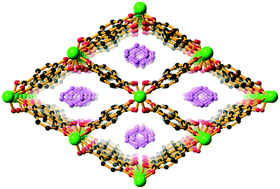Synthesis, structure and properties of coordination polymers formed from bridging 4-hydroxybenzoic acid anions†
Abstract
The combination of 4-hydroxybenzoic acid (H2hba) with Li+, Mg2+ and Cu2+ yields coordination polymers in which metal centres are bridged by an anion of the acid, either Hhba− or hba2−. In the case of Li+, a 3D network of composition Li2(hba)DMF was isolated in which parallel channels are occupied by coordinated DMF molecules. Mg2+ combines with H2hba to form a 2D square grid network with the formula Mg(Hhba)2(H2O)2. The alignment of parallel sheets results in the formation of channels filled with 1,4-dioxane molecules that hydrogen bond to coordinated water molecules. The compound Cu3(hba)2(OH)2(1,4-dioxane)1.5·0.5(1,4-dioxane) is a complex 3D network formed from the combination of Cu2+ with H2hba under basic conditions. The crystal structure determination reveals bridging 1,4-dioxane molecules. A reversible phase change occurs in the temperature range 200–220 K. The investigation highlights the key role of the solvent molecules in the structures of this series of compounds.

- This article is part of the themed collection: MOFs: three decades of pioneering research


 Please wait while we load your content...
Please wait while we load your content...